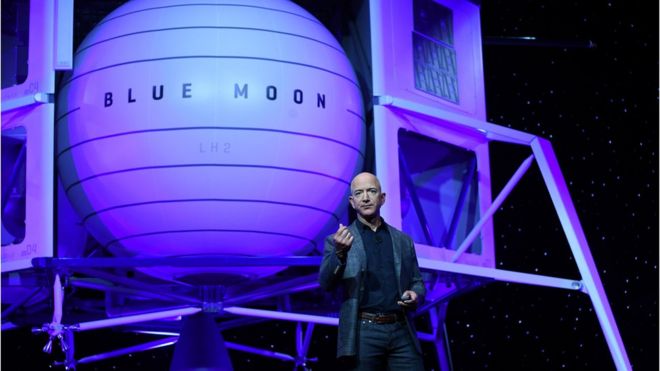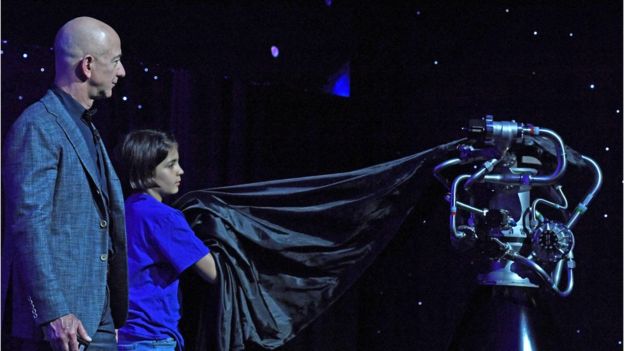Jeff Bezos unveils Moon lander concept
 REUTERS
REUTERS
Amazon entrepreneur Jeff Bezos has unveiled a mock-up of a new lunar lander spacecraft that aims to take equipment and humans to the Moon by 2024.
The unmanned, reusable Blue Moon vehicle will carry scientific instruments, satellites and rovers.
It will feature a new rocket engine called BE-7 that can blast 10,000lb (4,535kg) of thrust.
"It's time to go back to the Moon, this time to stay," said Mr Bezos.
Mr Bezos presented the Moon goals of his space exploration company Blue Origin at the Washington Convention Center in Washington DC, to an audience consisting of potential customers and officials from Nasa.
The Blue Moon lunar lander comes loaded with enough fuel to get from Earth to the Moon.
It can deliver payloads to the lunar surface, deploy up to four self-driving rovers, and launch satellites to orbit the Moon.
Blue Moon will weigh 33,000lb when loaded with fuel on lift-off from Earth, which will decrease to about 7,000lb when it is about to land on the Moon.
- Bezos rocket system flies for 10th time
- The billionaires fuelling a space race
- SpaceX Dragon demo capsule returns to Earth
- Branson's Virgin Galactic reaches edge of space
The aim is for Blue Moon to land on the south pole of the Moon, where ice deposits have been found in craters.
The water derived from that ice can be broken down to produce hydrogen, which could then fuel up the spacecraft for further missions across the solar system.
In March, the Trump administration announced that it intended to return US astronauts to the Moon by the end of 2024.
 REUTERS
REUTERS
In his speech, Mr Bezos said that Blue Origin would be able to meet Trump's deadline, but "only because" the firm had begun designing the lunar lander in 2016.
Mr Bezos wanted to improve access to the Moon, because he has a wider vision of a future where people are able to live and work in space, which is not possible today.
"The price of admission to do interesting things in space right now is just too high because there's no infrastructure," he said.
To illustrate this, he showed pictures of self-sustaining space colonies that could support people, animals and greenery - somewhat similar to the concepts developed by Princeton physicist Gerard O'Neill.



Ingen kommentarer:
Legg inn en kommentar
Merk: Bare medlemmer av denne bloggen kan legge inn en kommentar.